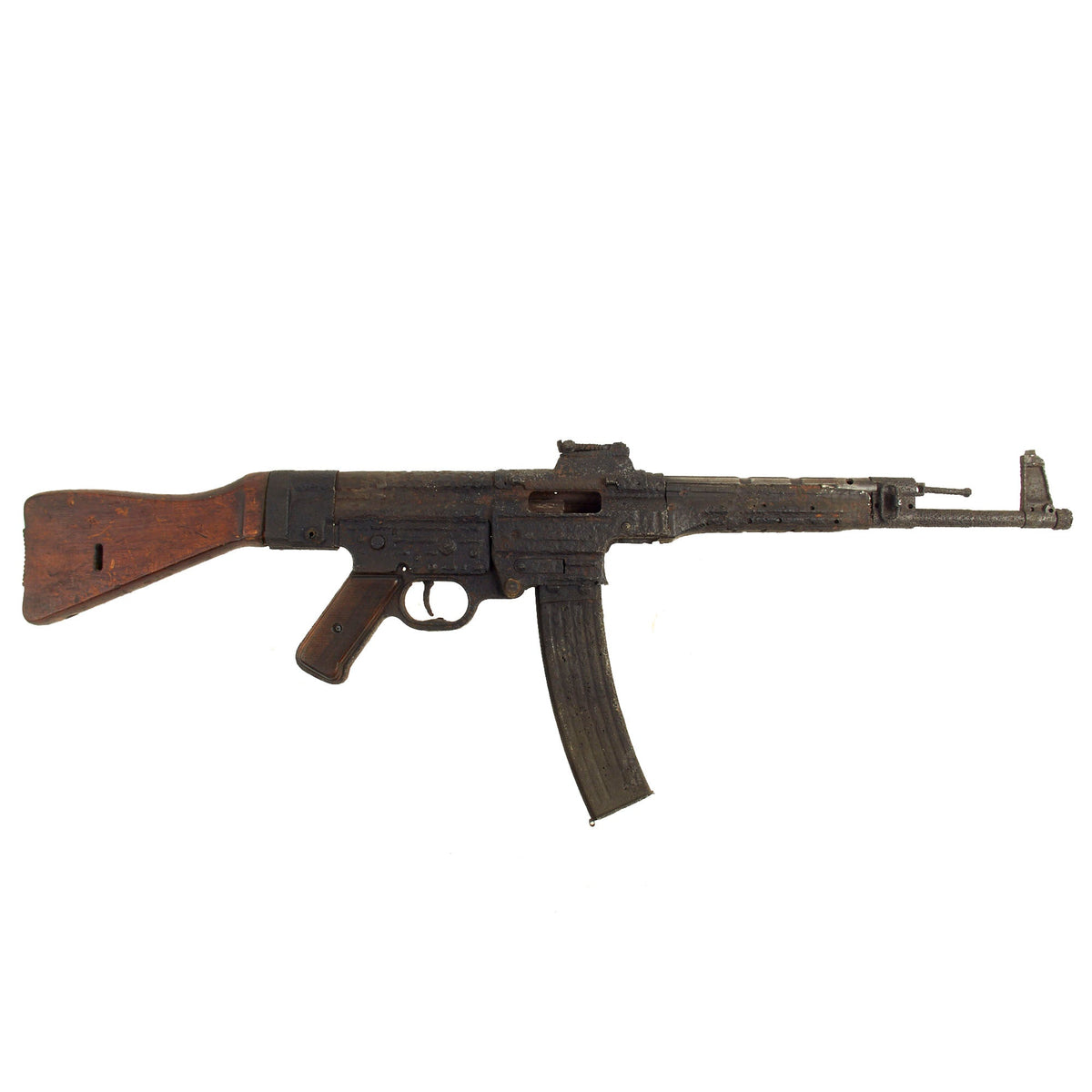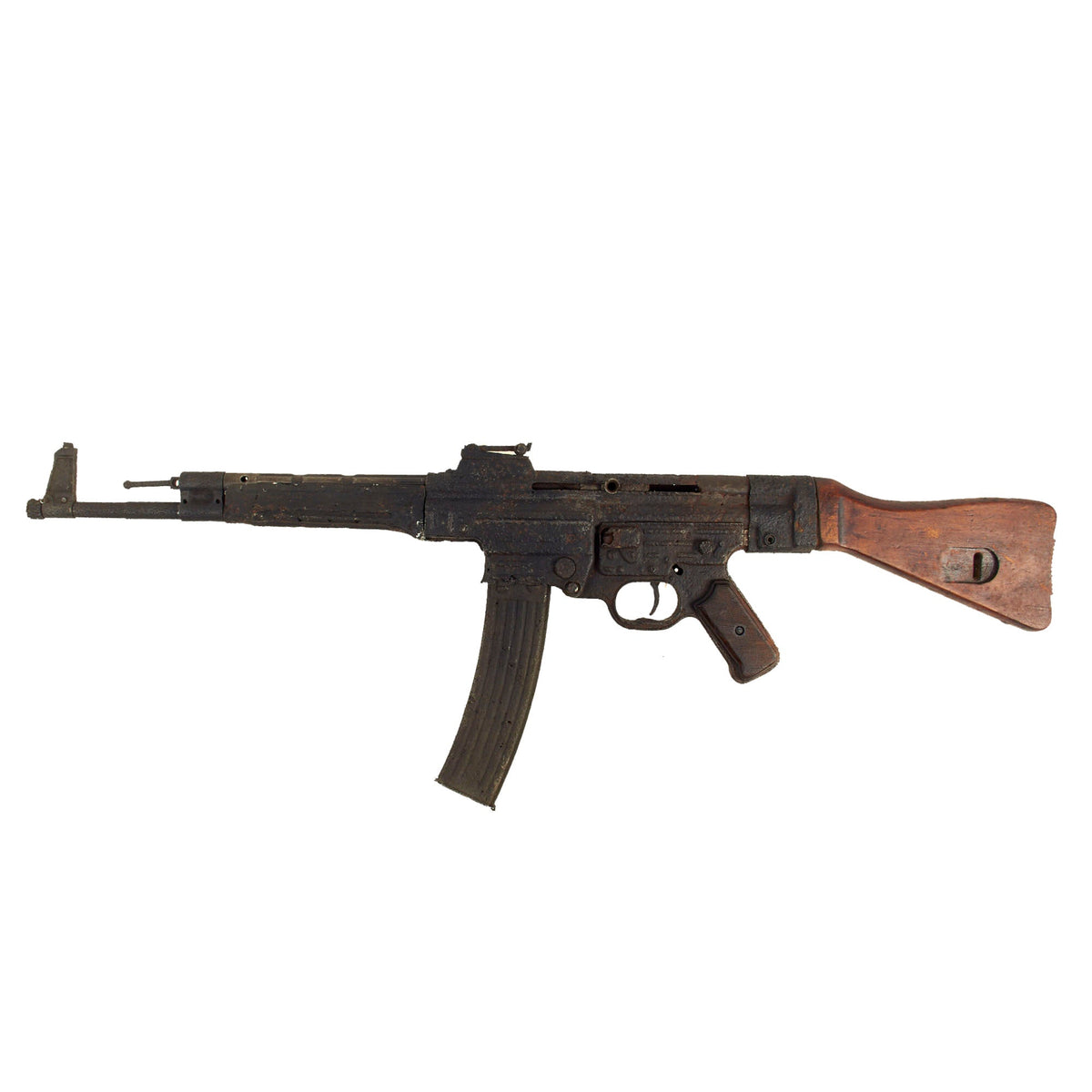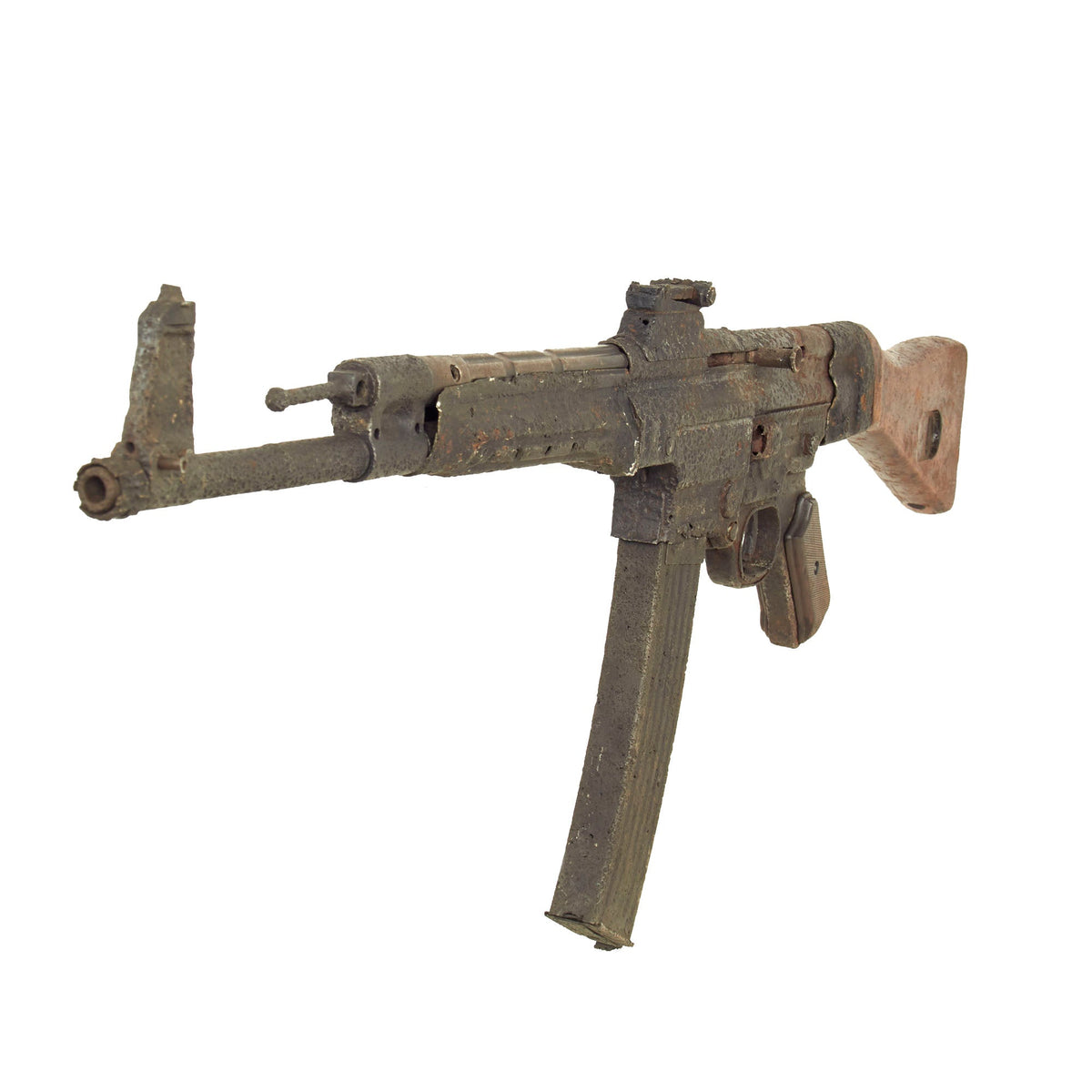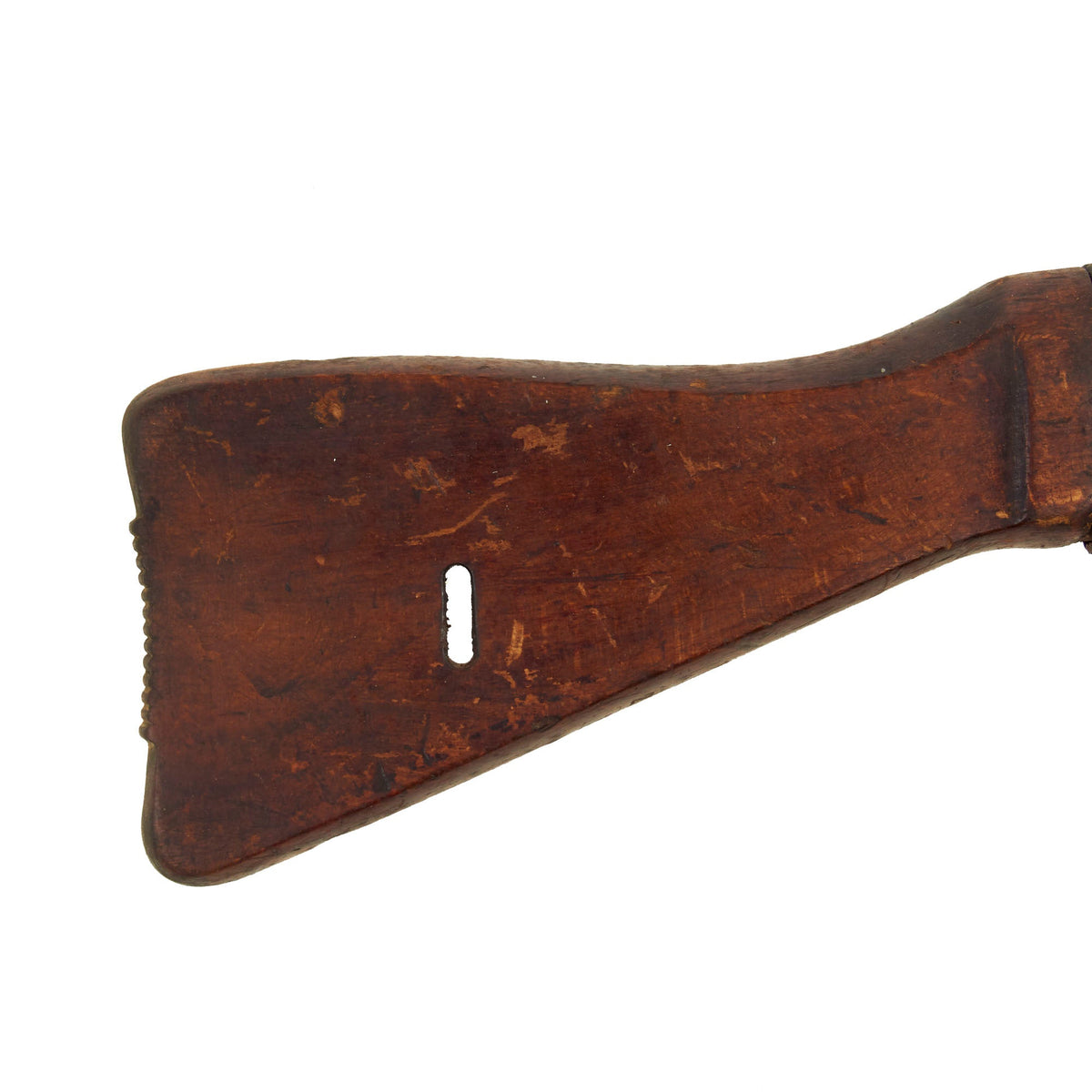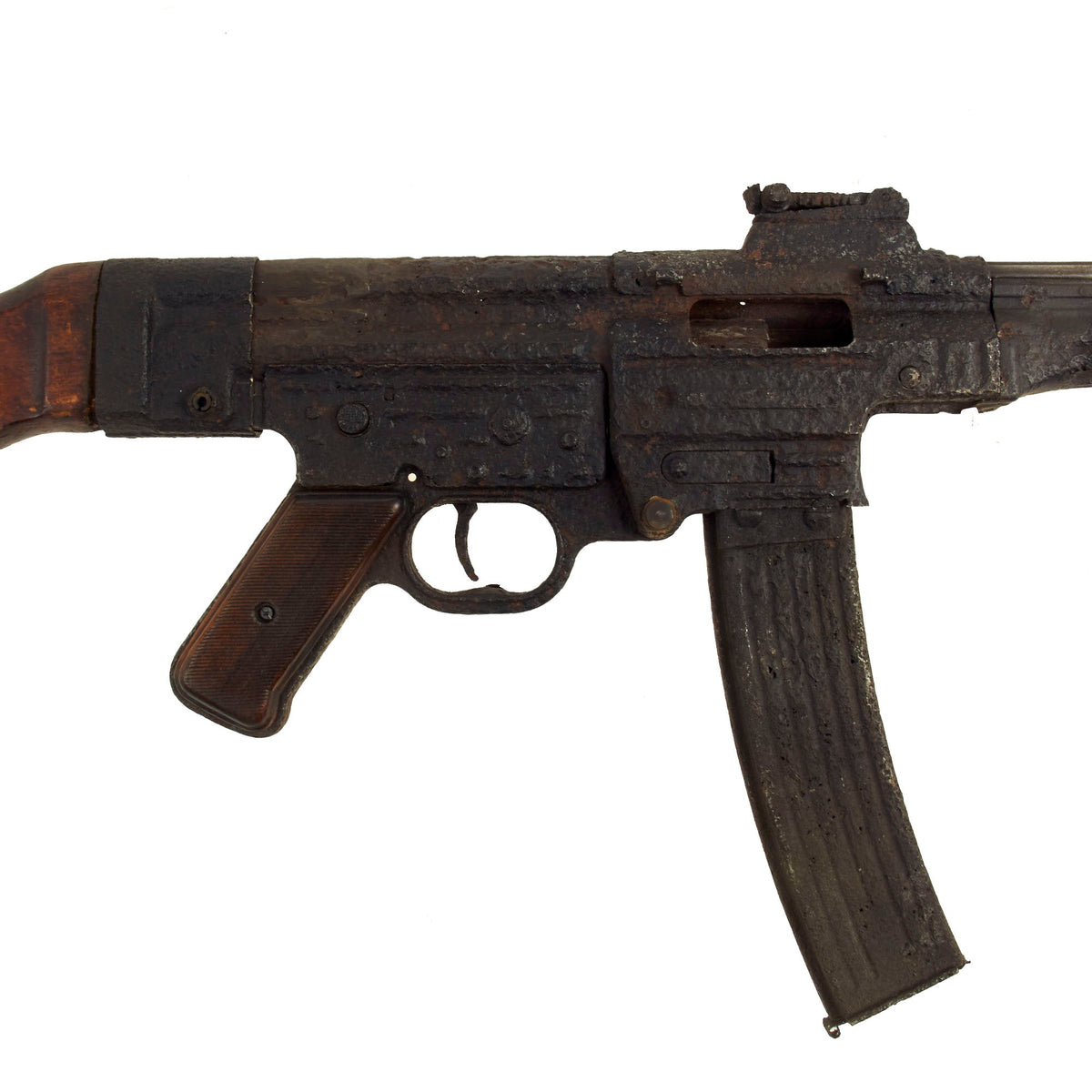Original German WWII Battlefield “Dug Up” Relic MP44 STG 44 Sturmgewehr Display Machine Gun with Magazine Original Items
$ 3.495,00 $ 873,75
Original Item: Only One Available. Now THIS is an offering for someone who really appreciates PATINA! This is a wonderful “Battlefield Dug Up” German WWII MP44 / STG 44 display machine gun, which were told was found in the Ardennes in France. Unfortunately we have no way of verifying this, as it was found some time ago, and all information on it passed on by word of mouth. The relic has been demilitarized and rebuilt with the proper 2 inches of what is left of the receiver replaced with solid bar stock, making this a great BATF approved relic display gun.
It has been cleaned and had treatment applied to stabilize the metal, and it looks like some material has been added to the barrel heat shield to stabilize it. The gun has also had original wooden grips and a butt stock fitted to complete the look. The barrel was also plug welded at some point, but aside from that it looks much as it did when first taken out of the ground and cleaned off. Called the Sturmgewehr (Storm / Assault Rifle) 44, it was considered by many to be the original pattern for the modern assault rifle. The MP44 was developed to give German troops fighting in Russia a means of delivering large volumes of fire at the seemingly endless supply of Soviet troops.
There are really no markings that we can still see anywhere on the display gun, and it is in overall somewhat delicate condition. There are some pieces of metal that are holding on almost by a thread, so it should definitely be handled with care. The magazine can be removed, and still locks in the place, though it does take some effort.
If you were looking for a fantastic conversation piece to be part of your WWII collection, this is it! This is a true collector’s piece that will only appreciate in value over the years to come!
History of the MP44-
The StG 44 (Sturmgewehr 44, literally “storm rifle” model of 1944 was an assault rifle developed in NSDAP Germany during World War II that was the first of its kind to see major deployment and is considered by many historians to be the first modern assault rifle. It is also known under the designations MP 43 and MP 44 (Maschinenpistole 43, Maschinenpistole 44 respectively), which denote earlier development versions of the same weapon with some differences like a different butt end, muzzle nut, shape of the front sight base or with an unstepped barrel, all only visible with close inspection.
MP 43, MP 44, and StG 44 were different designations for what was essentially the same rifle, with minor updates in production. The variety in nomenclatures resulted from the complicated bureaucracy in NSDAP Germany. Developed from the Mkb 42(H) “machine carbine”, the StG44 combined the characteristics of a carbine, submachine gun and automatic rifle. StG is an abbreviation of Sturmgewehr. The name was chosen for propaganda reasons and literally means “storm rifle” as in “to storm (i.e. “assault”) an enemy position”. After the adoption of the StG 44, the English translation “assault rifle” became the accepted designation for this type of infantry small arm.
The rifle was chambered for the 7.92×33mm Kurz cartridge. This shorter version of the German standard (7.92x57mm) rifle round, in combination with the weapon’s selective-fire design, provided a compromise between the controllable firepower of a submachine gun at close quarters with the accuracy and power of a Karabiner 98k bolt action rifle at intermediate ranges. While the StG44 had less range and power than the more powerful infantry rifles of the day, Wehrmacht studies had shown that most combat engagements occurred at less than 300 m, with the majority within 200 m. Full-power rifle cartridges were excessive for the vast majority of uses for the average soldier. Only a trained specialist, such as a sniper, could make full use of the standard rifle round’s range and power.
The StG 44’s receiver was made of heavy stamped and welded steel as were other contemporary arms such as the MP 40 and MG 42. This made for a fairly heavy rifle, especially one firing an intermediate-power cartridge. Difficulties with fabrication, the need to use available non-priority steels, and the exigencies of war resulted in a heavy receiver. U.S. military intelligence criticized the weight of the weapon along with the inclusion of the fully automatic feature which it considered “ineffectual for all practical purposes”, convinced that full automatic fire with StG 44 was permitted in emergencies only. This was a misinterpretation of the manual however, as the German manual states that automatic fire was “advised only in emergencies”, this was mainly to make sure that the regular soldier didn’t unnecessarily waste his ammunition spraying at targets, but instead fired in short accurate bursts to achieve maximum accuracy and effect; the StG could easily and safely be used in full automatic mode. The British were also critical saying that the receiver could be bent and the bolt locked up by the mere act of knocking a leaning rifle onto a hard floor. Many of these criticisms are more a testimonial of the Allied aversion rather than an accurate view of the weapon’s characteristics that were proven highly effective during combat in the war.
To its credit, it was the first successful weapon of its class, and the concept had a major impact on modern infantry small arms development. By all accounts, the StG 44 fulfilled its role admirably, particularly on the Eastern Front, offering a greatly increased volume of fire compared to standard infantry rifles. In the end, it came too late to have a significant effect on the outcome of the war.
Fast Shipping with Professional Packaging
Thanks to our longstanding association with UPS FedEx DHL, and other major international carriers, we are able to provide a range of shipping options. Our warehouse staff is expertly trained and will wrap your products according to our exact and precise specifications. Prior to shipping, your goods will be thoroughly examined and securely secured. We ship to thousands clients each day across multiple countries. This shows how we're dedicated to be the largest retailer on the internet. Warehouses and distribution centres can be located throughout Europe as well as the USA.
Note: Orders with more than one item will be assigned a processing date depending on the item.
Before shipping before shipping, we'll conduct a thorough inspection of the items you have ordered. Today, the majority of orders will be delivered within 48 hours. The delivery time will be between 3-7 days.
Returns
The stock is dynamic and we cannot completely manage it because multiple stakeholders are involved, including our factory and warehouse. So the actual stock may alter at any time. It's possible that you may not receive your order once the order has been made.
Our policy is valid for a period of 30 days. If you don't receive the product within 30 days, we are not able to issue a refund or an exchange.
You can only return an item if it is unused and in the same state as the day you received it. You must have the item in its original packaging.
Related products
Uncategorized
Uncategorized
Uncategorized
Band of Brothers ORIGINAL GERMAN WWII Le. F.H. 18 10.5cm ARTILLERY PIECE Original Items
Uncategorized
Armoured Fighting Vehicles of the World: AFVs of World War One (Hardcover Book) New Made Items
Uncategorized
Uncategorized
Uncategorized
Uncategorized
Uncategorized
Uncategorized
Uncategorized
Uncategorized
Uncategorized
Uncategorized
Uncategorized
Uncategorized
Uncategorized
Uncategorized
